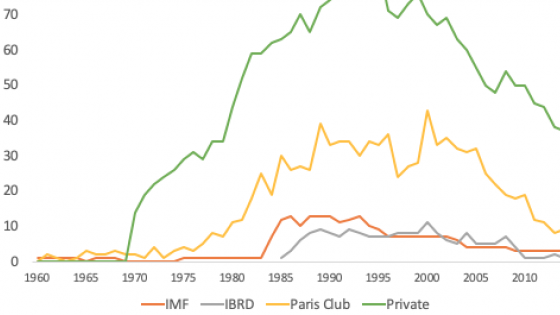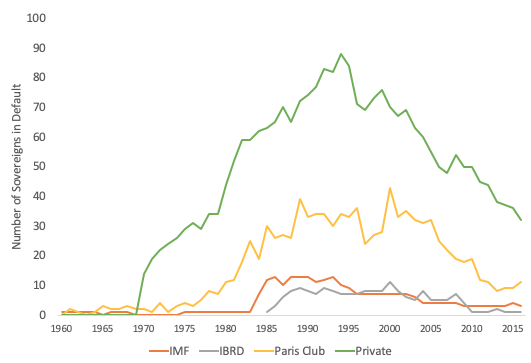In the aftermath of the 2002 crisis, Argentina paid off the IMF early, and repaid the World Bank and the Inter-American Development Bank in time and in full, while imposing a large haircut on private creditors.1 In contrast, in June 2005 Greece missed two payments to the IMF, amounting to about two billion euros, but paid on Greek ‘Samurai bonds’ issued in Japan. The IMF was eventually made whole, but other international financial institutions (IFIs), such as the European Stability Mechanism, agreed to participate in the debt restructuring, extending maturities and cutting interest rates.2 Moreover, the Argentine economy minister just announced that Argentina would have to seek to renegotiate amortisation payments including to the IMF.3 This serves as a salutary tale for IFIs, who are normally expected to be preferred.
Figure 1 The preferred creditor treatment of IFIs: Sovereigns in default by type of creditor
Source: Beers and Mavalwalla (2017), Bank of Canada Database of Sovereign Defaults.
Notes: Private here refers to foreign currency loans, bonds and other credit. IMF refers to in arrears with the International Monetary Fund and IBRD refers to in arrears with the International Bank of Reconstruction and Development (part of the World Bank Group). Paris Club refers to in arrears on bilateral loans extended by countries that are Paris Club members.
The preferred creditor treatment of the main IFIs is a longstanding puzzle in relation to sovereign lending. While the preferred creditor treatment is critical for the financial operations of IFIs, it is not backed by a clause in any legal contract and is normally referred to as a ‘market custom’. Countries have certainly defaulted less on IFIs than on bilateral or private creditors, as shown in Figure 1 (Beers and Mavalwalla 2017, Schlegl et al. 2019), but what are the drivers of this behaviour? Should IFIs participate in debt restructurings or, if not, are there limits––as the Greek experience suggests––to the amount of preferred IFI lending? Should IFIs discriminate across countries, and charge different interest rates depending on risk?
The existing economic literature does not provide much help in answering these difficult questions. Pages and pages have been written on sovereign lending, on why countries repay or default, and on whether the international financial architecture should be reformed.4 A lot of this work focuses solely on commercial lending. And, while there is a literature on IFIs (e.g. Bolton and Jeanne 2009, Corsetti et al. 2018, Gonçalves and Guimaraes 2015, Hatcheondo et al. 2017) , it tends to assume that they enjoy the preferred creditor treatment, even if it does not appear in legal contracts nor is backed by international law.5
Answers from a simple theoretical framework
In a recent working paper (Cordella and Powell 2019), we attempt to fill this gap. It is a theoretical paper with a relatively simple model of a country that can borrow from both the market and from an IFI in the wake of a large negative shock. The contribution of the paper is to explore the conditions under which a country treats IFIs as preferred and the market as junior, along an equilibrium path in which IFIs may add value. To strip things down to the bone, in our model, the only motive to repay a certain class of creditors is to keep the option of borrowing from them in the future open. We also make symmetric assumptions on default – if the country defaults on the market it can still borrow from IFIs, and if the country defaults on IFIs it can still borrow from the market – as we do not want to load the results in one direction or another. In other words, while remaining as neutral as possible we wanted to explore why a country might wish to borrow from an IFI, from the market, or both. This forced us to think carefully about the key difference between the two type of lenders.
In our view, the critical distinction is that IFIs can commit to restrict lending so that, in our simple set-up, they can actually lend risk-free, charge the risk-free interest rate and break even. In contrast to much of the literature, our simple approach allows us to provide analytical solutions. We do not need to rely on numerical simulations.
The results highlight the fundamental distinctions between private lenders that do not pretend to be senior and IFIs that are expected to be preferred. IFIs lend at low rates of interest that in general do not vary with risk – either across countries or as a country may be getting close to a crisis. But IFIs are almost always repaid, because they can restrict the amount of their lending.6 On the other hand, commercial lenders demand higher interest rates as default may occur, so in the end repayment is state contingent. The implication is that IFIs and private lenders are different animals and their lending serves different purposes. IFIs lend at low cost, but the expectation is that they will almost always be repaid. Market lending is more expensive but, if things do not turn out well, the country may default. There are situations in which a country is better off borrowing from both the IFI and from commercial lenders, but there are also situations in which only IFI borrowing or only market borrowing is at least as good for the country. The fact that IFIs can do something different and are not just another commercial lender suggests that, if IFIs were to adopt market-like policies (e.g. pricing according to risk), this would not make borrowers or the world better off. In fact, it turns out to be quite the opposite. It is only because IFIs can offer something different that they may add value.
Our other important message is that IFIs cannot lend unlimited amounts and expect to be preferred. Indeed, depending on the borrower’s characteristics, IFIs who want to maintain preferred creditor treatment should be wary about the amounts they lend. We also uncover a somewhat intriguing result, namely that there are situations in which the country is better off if market borrowing is not an option.7 Assuming the borrower can default on the IFIs and borrow from the market, this constrains the IFIs, limiting the relief (welfare) they might be able to provide by lending to the country. It may then be better for the country to be barred from commercial borrowing and thus be able to borrow more from IFIs.
As in any theoretical analysis, several caveats are in order. Ours is a relatively simple model and we abstract from issues such as the cooperative nature of some multilateral development banks, creditor coordination, liquidity, and the fact that countries might enact reforms and be persuaded to enhance their reform efforts through conditionality. Such considerations could be added and might provide further justification for IFI lending practices. We also focus on one-period loans and make stark assumptions about what happens if there is default. We make these simplifications to focus on the core incentives in a tractable model and to highlight what we consider to be the central findings.
Conclusions
With these limitations in mind, our results suggest something of a rethink about IFI emergency lending policy. There are three points we wish to stress to conclude. First, preferred creditor treatment may be justified as an equilibrium outcome, and so it is understandable why it is thought of as a market custom. When push comes to shove, if countries do not have incentives to respect the preferred creditor treatment, putting it in a contract is neither here nor there: sovereigns, after all, are sovereign. Second, there are limits to the use of preferred creditor treatment. IFIs cannot lend unlimited amounts with the expectation that they will always be repaid. Large packages funded from IFI balance sheets lent to countries that do not have the incentives to repay may well end in failure. This also suggests caution is in order in relation to proposals to seek sharing or expanding preferred creditor treatment beyond IFIs’ own resources. And finally, IFIs are different to private lenders. IFIs add value precisely because they are different and can offer contracts that the market cannot. Thanks to this they can lend at low interest rates in bad times. Hence, proposals that IFIs should price according to risk are misguided. By the same token, IFIs should not be treated like commercial lenders and they should not be asked to participate in debt restructurings.
References
Aguiar, M and M Amador (2014), "Sovereign debt", in Gopinath, G et al. (Eds.) Handbook of International Economics, Vol. 4, pp. 647-687, Amsterdam: Elsevier.
Beers, D and J Mavalwalla (2017), Database on sovereign debts, Bank of Canada, Technical Report #101.
Bolton, P and O Jeanne (2009) "Structuring and restructuring sovereign debt: The role of seniority", The Review of Economic Studies 76(3): 879-902.
Cordella, T and A Powell (2019), “Preferred and Non-Preferred Creditors”, World Bank Policy Research Working Paper 8941.
Corsetti, G, A Erce and T Uy (2018), "Debt sustainability and the terms of official support" CEPR Discussion Paper No. 13292.
Corsetti, G, A Erce and T Uy (2019), "Official lending in the Euro area: Lessons for debt sustainability", VoxEU.org, 13 February.
Cruces, J J and T R Samples (2016), "Settling sovereign debt’s trial of the century", Emory International Law Review 31: 5-47.
G20 Eminent Persons Group on Global Financial Governance (2018), Making the global financial system work for all.
Gonçalves, C E and B Guimaraes (2015), "Sovereign default risk and commitment for fiscal adjustment", Journal of International Economics 95: 68-82.
Hatheondo, J C, L Martinez and Y K Onderc (2017), "Non-defaultable debt and sovereign risk", Journal of International Economics 105: 217-229.
Martha, R (1990), "Preferred creditor status under international law: The case of the International Monetary Fund", The International and Comparative Law Quarterly, 39: 801-826.
Schlegl, M, C Trebesch and M L Wright (2019), "The seniority structure of sovereign debt,", NBER working paper 25793.
Endnotes
[1] See Cruces and Samples (2016) for the story of the Argentine restructuring. IFIs are notable by their absence throughout their telling of the “trial of the Century”.
[2] See for example “Argentina seeks to restructure $101bn of debt” Financial Times, 29 August 2019.
[3] See the recent Vox column by Corsetti et al. (2019), who argue that the restructuring of official debt was a turning point for the Greek crisis. Notice, however, that this restructuring was somewhat at odds with the following Euro area governments’ statement: “[European Stability Mechanism] loans will enjoy Preferred Creditor Status (PCS), in a similar fashion to those of the IMF, being junior only to IMF loans,” see https://www.esm.europa.eu/glossary/P
[4] See, for instance, Aguiar and Amador (2014) and, for a policy discussion, The G20 Eminent Persons Group on Global Financial Governance (2018).
[5] On this point, see Martha (1990).
[6] Arguably, the case of Greece, or of Sudan where the IMF built up large exposures in the 1980s, which ended in long-term arrears, illustrate the risks of large lending programs where repayment incentives might be weak.
[7] In relation to lending to low-income countries, this is part of the non-concessional borrowing policy in multilateral development bank jargon – our results might be read as a possible justification for this approach.




